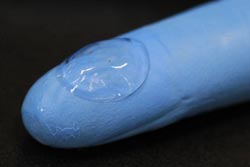Korean researchers demonstrate a new class of transparent, stretchable electrodes

LED fitted soft eye contact lense<br>
UNIST scientists have combined graphene with silver nanowires to form a thin, transparent and stretchable electrode which overcome the weaknesses of each individual material, resulting in a new class of electrodes with widespread possible applications including picture taking and scanning using soft contact lenses.
Transparent electrodes have been widely used in things like touch screens, flat-screen TVs, solar cells and light-emitting devices. Commonly made from indium tin oxide(ITO), it is brittle and cracks thus losing functionality if flexed. It also degrades over time, and is expensive due to the limited quantities of indium metal.
As an alternative, the networks of randomly distributed mNWs have been considered as promising candidates for next-generation transparent electrodes, due to their low-cost, high-speed fabrication of transparent electrodes. However, the number of disadvantages of the mNW networks limited their integration into commercial devices. They have low breakdown voltage, typically high NW-NW junction resistance, high contact resistance between network and active materials, material instability and poor adhesion to plastic substrates.
Graphene is also well known as good a candidate for transparent electrode because of their unique electrical properties and high mechanical flexibility. However, scalable graphene synthesis methods for commercialization produces lower quality graphene with individual segments called grains which increases the electrical resistance at boundaries between these grains.
Silver nanowires, on the other hand, have high resistance because they are randomly oriented like a jumble of toothpicks facing in different directions. In this random orientation, there are many contact between nanowires, resulting in high resistance due to large junction resistance of nanowires. Due to these drawbacks, neither is good for conducting electricity, but a hybrid structure, combined from two materials, is.
The hybrid material presents a high electrical and optical performance with mechanical flexibility and stretchability for flexible electronics. The hybrid transparent electrode has a low “sheet resistance” and high transmittance. There’s almost no change in its resistance when bent and folded. Where the ITO is bent, its resistance increases significantly. Additionally the hybrid material preserve its electrical and optical properties against thermal oxidation condition
The graphene-mNW hybrid structure developed by the UNIST research team is a new class of electrodes and may soon find use in a variety of other applications. The research team demonstrated Inorganic light-emitting diode (ILED) devices fitted on a soft eye contact lens using the transparent, stretchable interconnects of the hybrid electrodes as an application example.
As an in vivo study, this contact lens was worn by a live rabbit eye for five hours and no abnormal behavior, such as bloodshot eye or the rubbing of eye areas were observed in the live rabbit. Wearing eye contact lenses, picture-taking and scanning, is not science fiction anymore.
The research was led by Jang-Ung Park, professor of the School of Nano-Bioscience and Chemical Engineering at UNIST. “We believe the hybridization between two-dimensional and one-dimensional nanomaterials presents a promising strategy toward flexible, wearable electronics and implantable biosensor devices, and indicate the substantial promise of future electronics,” said Prof. Park.
Journal information
Published online on May 23, 2013 in Nano Letters. (Title: High-Performance, Transparent and Stretchable Electrodes using Graphene-Metal Nanowire Hybrid Structures.)
Funding information
This work was supported by the National Research Foundation of Korea and the Ministry of Knowledge Economy through the Materials Original Technology Program.
Media Contact
All latest news from the category: Power and Electrical Engineering
This topic covers issues related to energy generation, conversion, transportation and consumption and how the industry is addressing the challenge of energy efficiency in general.
innovations-report provides in-depth and informative reports and articles on subjects ranging from wind energy, fuel cell technology, solar energy, geothermal energy, petroleum, gas, nuclear engineering, alternative energy and energy efficiency to fusion, hydrogen and superconductor technologies.
Newest articles

Silicon Carbide Innovation Alliance to drive industrial-scale semiconductor work
Known for its ability to withstand extreme environments and high voltages, silicon carbide (SiC) is a semiconducting material made up of silicon and carbon atoms arranged into crystals that is…

New SPECT/CT technique shows impressive biomarker identification
…offers increased access for prostate cancer patients. A novel SPECT/CT acquisition method can accurately detect radiopharmaceutical biodistribution in a convenient manner for prostate cancer patients, opening the door for more…

How 3D printers can give robots a soft touch
Soft skin coverings and touch sensors have emerged as a promising feature for robots that are both safer and more intuitive for human interaction, but they are expensive and difficult…





















